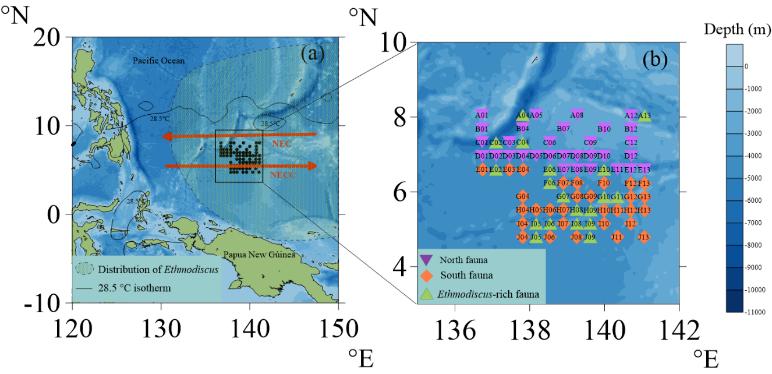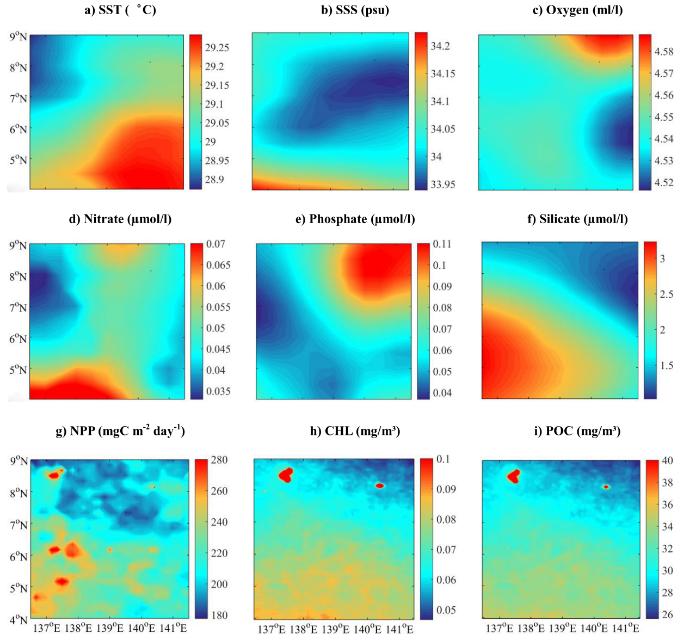The Western Pacific Warm Pool (WPWP) contains the warmest surface waters exceeding 28.5°C, being the earth's heat engine and influencing global climate change. This region is also reported to be excessively oligotrophic, possibly induced by a strong pycnocline isolating surface waters from subsurface nutrient pools.
However, it is unclear how radiolarians, a major group of marine microzooplankton, respond to the typically warm oligotrophic condition of WPWP.
Recently, the research team led by Prof. LI Xinzheng from the Institute of Oceanology of the Chinese Academy of Sciences (IOCAS) provided new insight into the radiolarian assemblages in the western WPWP and environmental determinants that controlled species composition.
The study was published in Deep Sea Research Part I: Oceanographic Research Papers.
Researchers identified three major radiolarian faunas in surface sediment samples of the western WPWP: the North fauna, South fauna, and Ethmodiscus-rich fauna.
Co-occurrences of highly abundant radiolarians and Ethmodiscus diatom fragments are recorded in the Ethmodiscus-rich fauna. For this observation, two hypotheses were proposed: radiolarian assemblages coexist in the upper column during Ethmodiscus blooms, or assemblages represent co-preservation in a sediment thanatocoenose.
Primary production is the strongest factor controlling the species composition of the northern and southern faunas in the WPWP waters. North fauna shows an adaption to lower primary production, while South fauna prefers higher ones.
According to the results, researchers suggest that primary production, likely associated with food availability, is a major determinant of radiolarian assemblages in the oligotrophic WPWP. It is known that radiolarians are mainly heterotrophic plankton, feeding on copepods, microalgae, and cyanobacteria, and the latter two are producers of primary production. Besides heterotrophic species, some radiolarians are also reported to maintain photosymbionts.
Some radiolarian taxa have higher abundance in more productive waters, probably indicating their heterotrophic nutrition with heavier dependence on food availability. Several other species, reported to harbor obligate photosymbionts, are abundant in less productive waters, suggesting their reduced food dependence on microplankton.
"Results of this study highlight radiolarians may serve as potential proxies of surface primary production in warm stratified waters," said Prof. LI.
This work was supported by the Global Change and Air-Sea Interaction Project granted by the Ministry of Natural Resources of China, and the Senior User Project of RV KEXUE (KEXUE2020GZ01 to Xinzheng Li).

Fig. 1 Location of the surface sediment samples in the western equatorial Pacific (a), and the main radiolarian faunas (b).

Fig. 2 Annual mean sea-surface oceanographic conditions in the western WPWP

Fig. 3 Principal coordinates analyses of radiolarian assemblages in the western WPWP (a), and redundancy analysis of North and South samples (b). Abbreviations: PP-primary production, SST-sea surface temperature.
Hanxue Qu, Jinbao Wang, Yong Xu, Jishang Xu*, Xinzheng Li*. (2022). Radiolarian assemblages controlled by ocean production in the western equatorial Pacific. Deep Sea Research Part I: Oceanographic Research Papers, 182: 103721.
LI Xinzheng
Institute of Oceanology
E-mail: lixzh@qdio.ac.cn
(Editor: ZHANG Yiyi)
|
|

Address: 7 Nanhai Road, Qingdao, Shandong 266071, China
Tel: 86-532-82898902 Fax: 86-532-82898612 E-mail: iocas@qdio.ac.cn


